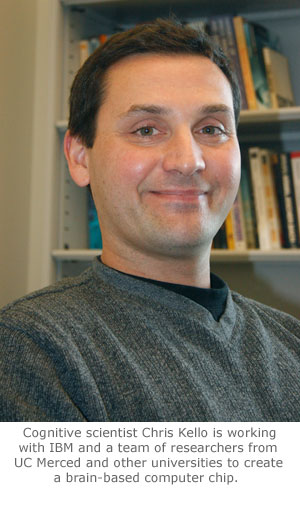

Today’s most powerful computers can crunch numbers with a speed and precision that truly boggles the mind. But when it comes to the mind and its perceptual and mental capacities, even supercomputers pale in comparison.
“Computers can guide a rocket to Mars and deploy rovers to transmit video data back to earth, but to search for interesting features on the surface of Mars, humans are still needed to guide the robot and interpret its video data,” says UC Merced
researcher
Chris Kello.
In fact, computers are generally incapable of learning about their environments and adapting their behaviors in ways that come natural to mice and even simpler biological organisms. Differences in the capabilities of brains versus computers are also reflected in their circuitry. Today’s computer chips are nothing like networks of neurons, the cells that transmit and process information in the brain.
Tomorrow’s computer chips, however, may be designed more like neural networks to harness the power of biological intelligence. This sounds like the stuff of science fiction, but a team of UC Merced researchers are working to help make this fiction become reality.
UC Merced is one of five universities working with IBM to design new computer circuitry that mimics the brain. IBM leads the “cognitive computing” project that was announced in late November and is funded by a $4.9 million grant from the US Defense Advanced Research Projects Agency.
Co-leading the UC Merced group is Kello, associate professor of
cognitive science, and
Paul Maglio, UC Merced adjunct professor of cognitive science and senior manager at IBM Almaden Research Center. Also part of the UC Merced group is
David Noelle, assistant professor in the schools of
Engineeringand
Social Sciences, Humanities and Arts; and Marshall Mayberry, postdoctoral researcher in cognitive science.
The project includes engineers who are using nanotechnology to build neural circuits and an interdisciplinary team of scientists (neuroscientists, computer scientists, and cognitive scientists) who are designing the circuits based on how brains work. The task for the UC Merced group is to design and create virtual environments (think “Second Life”) in which circuits can be trained and tested.
The need for virtual environments stems from the nature of biological intelligence. Kello says that “humans and mice and other biological organisms tune their perceptual and cognitive capabilities by exploring and interacting with their environments. Our neural circuits will need to tune their capabilities in the same way.”
The six-phase project could take close to a decade to complete, and the research team - which also includes scientists from Stanford University, the University of Wisconsin-Madison, Cornell University and Columbia University Medical Center - must achieve specific milestones along the way to continue receiving DARPA funding. These milestones include demonstrations of perception, navigation, planning, and decision-making in virtual environments.
The project requires an uncommon breadth of experience and knowledge that Kello has acquired by working at the National Science Foundation before coming to UC Merced, including a CAREER award from NSF’s Perception, Action and Cognition program.
“Cognitive science is a highly interdisciplinary field that integrates psychology, neuroscience, computer science, linguistics and philosophy,” he said. “The central role of cognitive science to this project really speaks to the growth and maturity of the field, and to the vision of UC Merced’s investment in cognitive science.”






